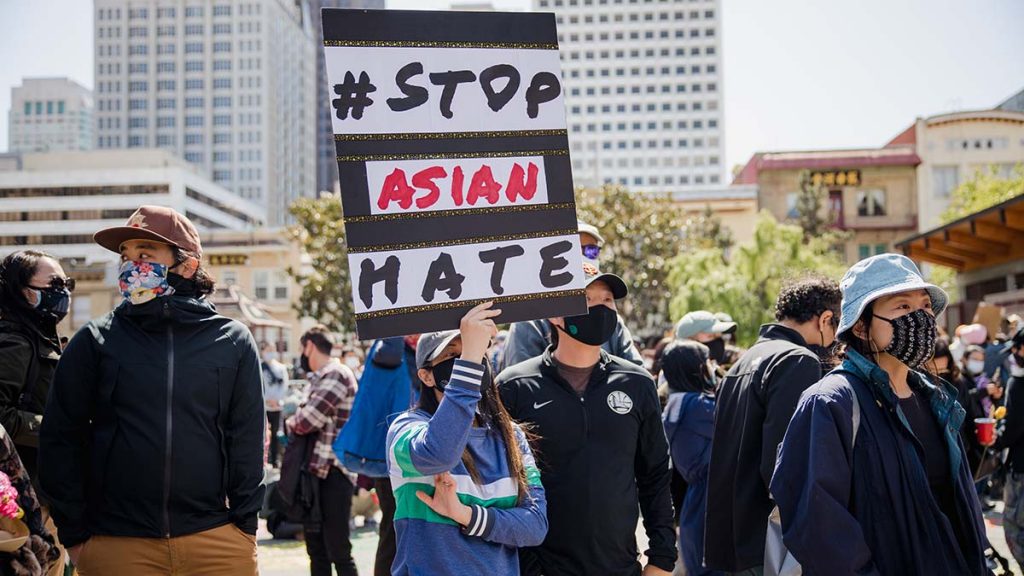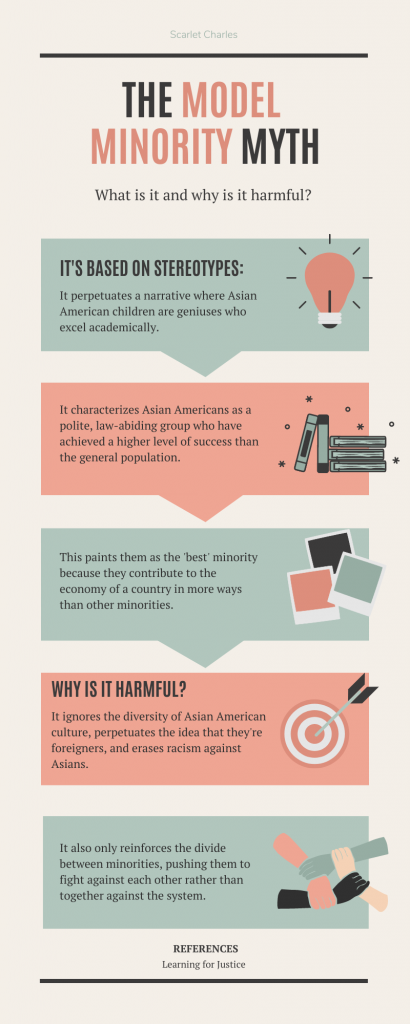There has been a rise in anti-Asian related hate crimes during the COVID-19 pandemic. How have Asian communities used digital technologies to help combat racism?

Get in; Grab ice cream; Get out. It was a simple task, but for Jane Kim, it felt gargantuan. She lived in Queens, New York, in the epicentre of the pandemic in the United States, and she felt terrified every time she had to leave her flat.
“I was trying to avoid COVID, of course, but predominantly, I was trying to avoid a racist attack,” she admits. But like many other Asian people over the pandemic, she was victim to a hate crime.
Over the past year, there has been a rise in anti-Asian hate crimes across the world. When Donald Trump called the virus a ‘Chinese virus’, it racialised a biological virus and added to the already-existing stereotype that Asian communities were disease carriers, as seen with SARS 2003. The internet then picked up that term, and it went viral. This led to people associating the words ‘COVID’ with ‘Chinese’, and that created an implicit bias in how people view Chinese people or people who look Chinese.
As a response to this, activists around the United States created a coalition and campaign group called Stop AAPI Hate. The website is a platform where people around the country can report any instance, they were victims of discrimination or a hate crime. It then tracks that data and issues policy reports.
Russell Jeung, a professor, and San Francisco State University and one of the group’s founders who describes himself as a scholar-activist, explains that “the content we have has to come from the voices of real Asian Americans who experience stuff in real life.”
Though Stop AAPI Hate is a website, Russell Jeung explains that they don’t have that much to do with social media. He says, “We actually didn’t do that much digital media content. We knew other groups were already raising awareness on the issue. We didn’t have to do that aspect; we focus on our lane and focus on data collection and policy formulation.”
Stop AAPI Hate, in fact, impacted Asian communities all around the world. This led to the creation of what Russell Jeung describes as the ‘hashtag movement’, called Stop Asian Hate. This movement became so popular, people around the world started using it. Protests happened all across the United States, but also in Canada, in Taiwan, and in capital cities in Europe. Yet, the issue of Asian racism is still overlooked when talking about systemic racism. For instance, when the hashtag #StopAsianHate was trending in March 2021, #BlackLivesMatter was still trending nearly three times as much.

Jane Kim, who is an activist and educator, tries to explain why it is neglected when talking about racism, and what the limits to this global digital movement are. One factor that she mentions is the lack of tech access.
She says, “I think there are barriers in terms of tech access and tech literacy. So even when you have Asian elders who were being abused and assaulted, they go onto this website to report something that has happened. How do they get onto the website? They need to be able to have internet access. They need to be able to know how to navigate a website. They need to be able to have these tech literacy skills to be able to do the first step of reporting.”
Indeed, while smartphone use amongst the elderly quadrupled in the past five years, studies show that 49% don’t have WiFi in their home, and only 17% of citizens over 80 years old own a smartphone. On top of that, there has been an increase in assaults towards elderly Asian people in the US. How then can an issue that affects people of every age be solved, if not everyone is represented? Russell Jeung explains that this is an issue the Stop AAPI Hate website has experienced.
“The limits of being a website to collect racism is that we have clearly a self-selecting group report to us,” he explains. “Those who are educated, those who know about us, those who have access to the internet. And some groups don’t have access, even though we have multiple languages.”
And yet, despite this, within a few hours of launch, the website got hundreds of complaints. Russell Jeung explains that is because of the parallel ‘hashtag movement’ to their campaign.
“We’ve benefited from the broader movement,” he admits. “There are a lot of campaigns that alert people to what was happening. Asian influencers sounded the alarm. And because there was a lot of also viral messaging, to fight racism, I think that both alerted people to the issue and created enough bias that policymakers and mainstream media picked up on it. That just shows the trust the community has in our organisations, and the widespread pervasive nature of the racism and how much people are wanting to give voice to it and share their stories.”
But Jane Kim argues that one of the reasons why Asian struggles aren’t talked about more is because of the lack of media representation of issues that affect Asian communities.
“Who’s doing the reporting,” she asks. “What are the barriers to that reporting? Who has the kind of following? Who has larger platforms to be able to talk about these things? If we look at representation, even in large spaces, whether it’s politics, whether it’s Hollywood, whether it’s well-known figures, how often are Asian Americans represented? How often are Asians represented in those fields? So, representation matters. Good representation matters. It’s not that people are voiceless, right? It’s not that people don’t have feelings. But who is providing the space, and the time, and the platform, to amplify the issues?”
Just looking at Hollywood and the media, the stereotype of the Asian character is always a geeky, smart, and passive friend or sidekick. Only in recent years has that stereotype started breaking, with movies and series like Shang-Chi, Crazy Rich Asians, or Kim’s Convenience, that portray main characters as multi-faceted. And this is because of people complaining, of activism. Jane Kim says that this change is thanks to the contribution of black people to the civil rights movement.
“Asian Americans, even as a label would not exist were it not for black activists and African-American leaders who fought for civil rights,” she says. “We would not be here, had it not been for the suffering and the struggle of black Americans. And so, people are finally realising and now opening their eyes to see how deeply racism is embedded into the fabric of America. What’s so beautiful about the movement is that it’s centring black joy, centring black love. Making sure that people are seeing beyond just the objectifying suffering that they go through. So, I think that’s something that we all can learn from.”
A lot of people have been comparing the struggles of Asian communities and black communities over the past year, claiming the ‘model minority’ myth as an excuse. This myth concerns members of minorities who are perceived as contributing most to society, through socio-economic success. It is most often applied to Asian Americans. Because of this myth, there has been a lot of competition between both communities, dividing them rather than unifying against systems that perpetuate the stereotypes.

“You always have to be critical and take a step back and think about why is it that you only see videos of black perpetrators,” Jane Kim explains when mentioning the distrust that some Asian communities have against black people because of media representation.
“Why are those areas so heavily policed and why are there so many cameras? And then you also have to think about larger structures and systems. If you look at the data, a University of Michigan study found that of the reports of Asian hate crimes or Asian violence that happened, I believe in 2020, 90 to 91% of it was by white perpetrators and only 5% were black. Social media tells a different story. And so, I think it’s important for us to have a critical lens and critical kind of thinking.”
The biggest difference between the two movements is that Black Lives Matter has a bigger platform than Stop AAPI Hate: 4.4million followers compared to 205,000 on Instagram. But both Jane Kim and Russell Jeung agree that social media is only a step in the grand scheme of activism.
“If your activism starts and stops with just social media, there’s an issue,” says Jane Kim. “Social media is a tool, but we really need to focus on local communities, on lawmakers making sure that we have policies that are changing.”
“For a movement, not only do you need awareness, but we also need data to document the issue,” explains Russell Jeung in turn. “Then we can actually go to policymakers and say this is a concrete issue that’s affecting a large percentage of people. If we didn’t have data, we wouldn’t be able to frame the issue showing how widespread it is, or how it’s systemic, or how it’s connected to political rhetoric. And so, I think having both the data and the narrative, we were able to use social media to amplify. I think digital media, activism is helpful for raising awareness of issue amplifying issue, but the actual concrete solutions to an issue have to come out of policy formulation and real concrete communications with real people.”

But the difference in popularity on social media between the two doesn’t make it’s more or less important or urgent. Instead, Russell Jeung conveys how Black Lives Matter’s popularity has helped his website grow and reach more people.
“Because Black Lives Matter has paved the way, corporations and policymakers are more attuned to it,” he says. “A lot of the corporations we talked to said, ‘We started this speaker series because of Black Lives Matter and now we’re focusing on Asians’. So, it’s just paved the way for us.”
However, he questions we must be asking ourselves is why are people acting differently towards different minority groups? Is anti-racism finite? There will always be preconceptions about people, and the way forward is by working together.
Jane Kim concludes, “The important thing is for us to keep fighting and for change and pursuing justice and pursuing accountability. Even if the cameras are not on us, even if the white gaze is not focused and paying attention. We have to keep fighting.”
